The Living God
It was afternoon when I stepped out of a local bus and asking for directions to a temple. A young gentleman happily gave me the directions and also helped me find an auto. He gave instructions to the driver to drop me at my destination. Finally, I arrived in a small village of Kerala in Kannur district searching for the Gods, the living Gods of Kerala known as “Theyyam”.
“Sir, you are there”, said the driver pointing in the direction where I could see a small group of young volunteers moving fire wood in preparation for something.
It was a small ground around the temple. I was curious to understand what was it all about. The only way I could feed my curiosity was by asking the locals about it. Just then an old gentleman came to me and asked me politely “Are you here to watch Theyyam? ”When I said, “Yes”, immediately he led me to the temple and offered hot tea. The second question was ‘if I was hungry and he went on to say, “Please have lunch with us and feel free like your home”.
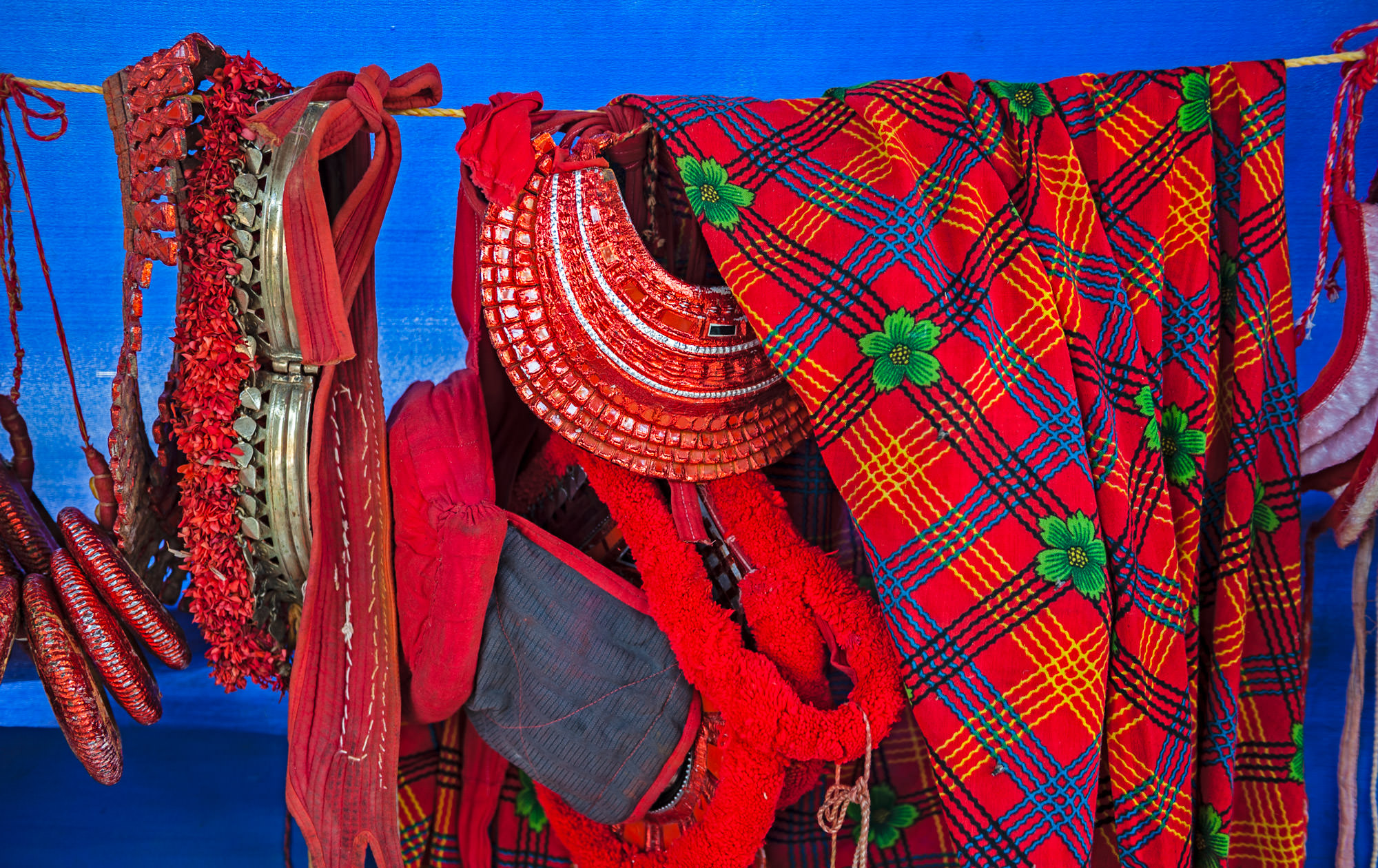
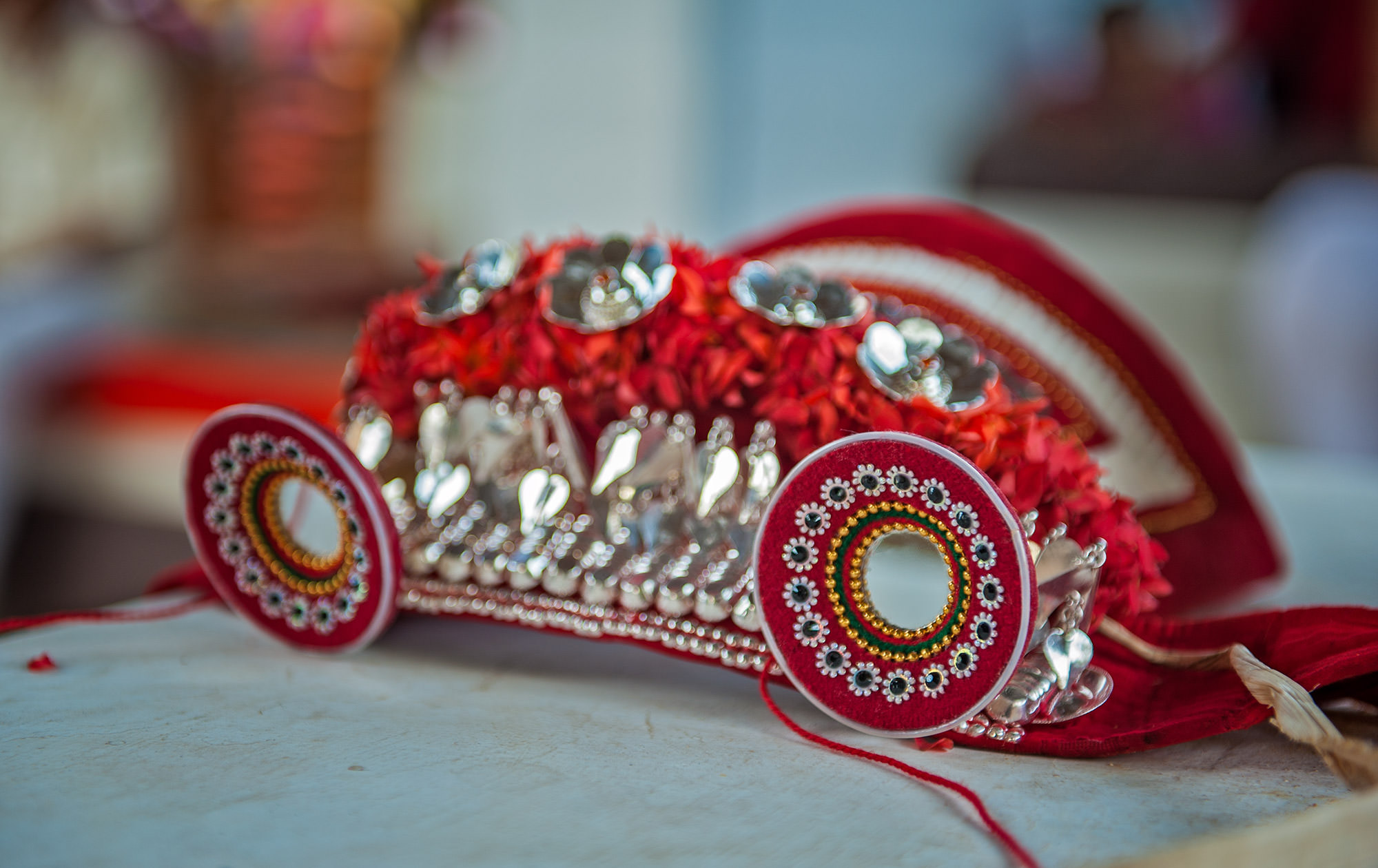
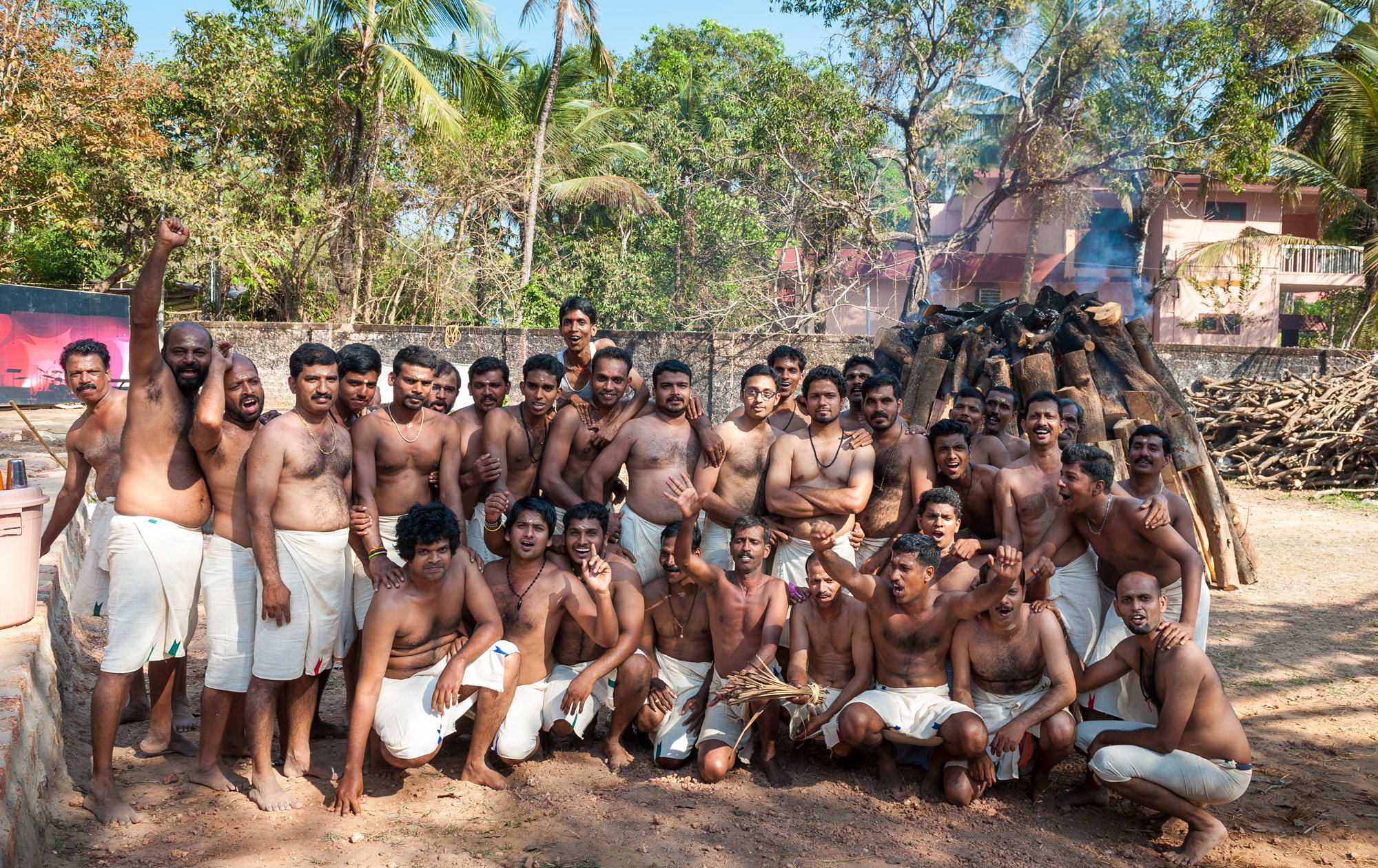
It was a typical Kerala village, with a myriad of coconut palms, adorned by the cool sea breeze and radiant sunshine as if nature personally blesses the land and its people. Water was sprinkled on temple ground and the whiff of burning firewood filled the atmosphere with mystery and excitement. The emanating smoke was like a beacon getting the people to the temple and around the fire. Most of them must have walked many miles through the small paddy farms to get here. They were all waiting for the moment when the Gods would descend to the earth for dance only once a year. They all were ready to wait all night long to be blessed by their living Gods.
As I was looking around I saw a group of drummers who were drumming with an increased tempo. Incessant beats were created with the help of hard tamarind wood drumsticks. Every beat of the drum gradually got louder and faster, this was an announcement in a way that the grand ceremony was about to start for everyone present in the Kavu. Kavu is the traditional name given for sacred groves across the Malabar Coast. I saw a young man being blessed by the chief priest and deity to begin some kind of a ritual. I was told by the old gentleman, that the ceremony was about to begin. Drums were getting louder and louder while a song was being sung by a young man in the temple. Suddenly, everyone was rushing out from Kavu and gathering around the holy fire, where the ceremony had begun.
A young man dressed up in red robes was singing songs narrating the story about God victory while encircling the fire. I was told it is known as Tottan but not Theyyam. Theyyam would be performed the next morning around 5:00 am and entire crematory will continue for two days and also during the night. I sensed a lot of excitement in the crowd and Tottan was circling around the full-blown fire for almost two hours, tirelessly. I wondered how a person could have so much energy and I could not stop myself from capturing this energy filled event. I don’t think any camera can really capture this energy in a frame.
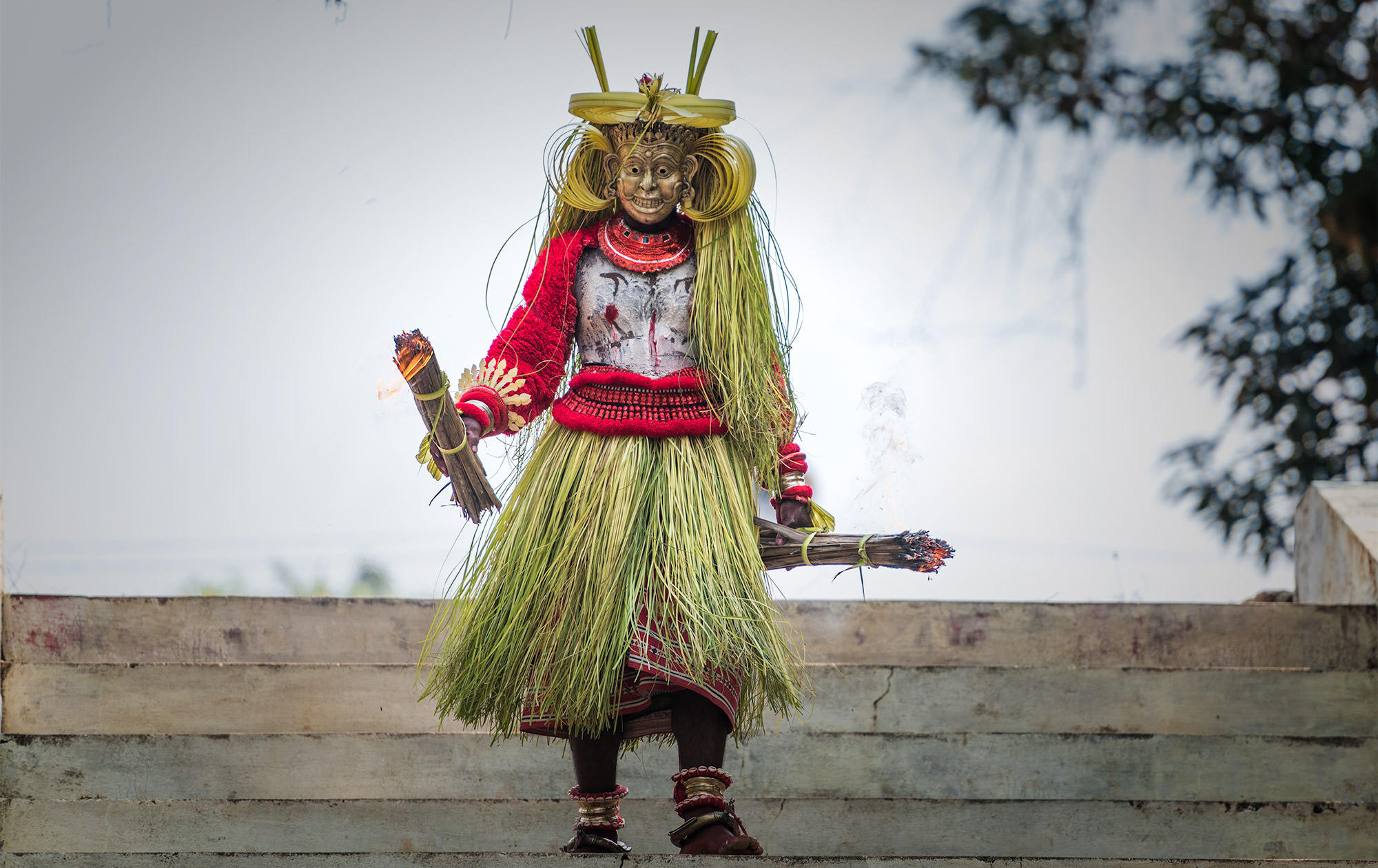
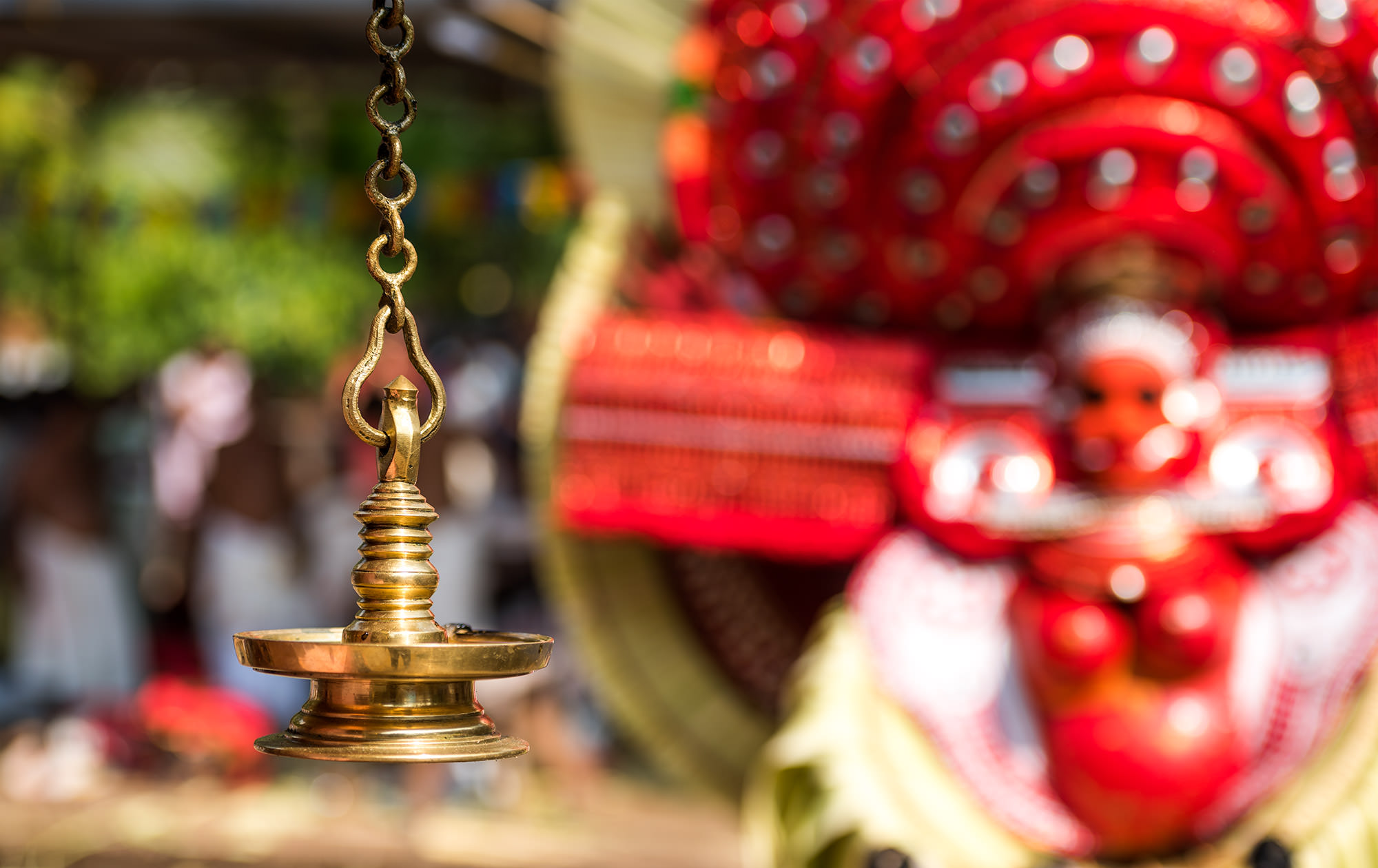
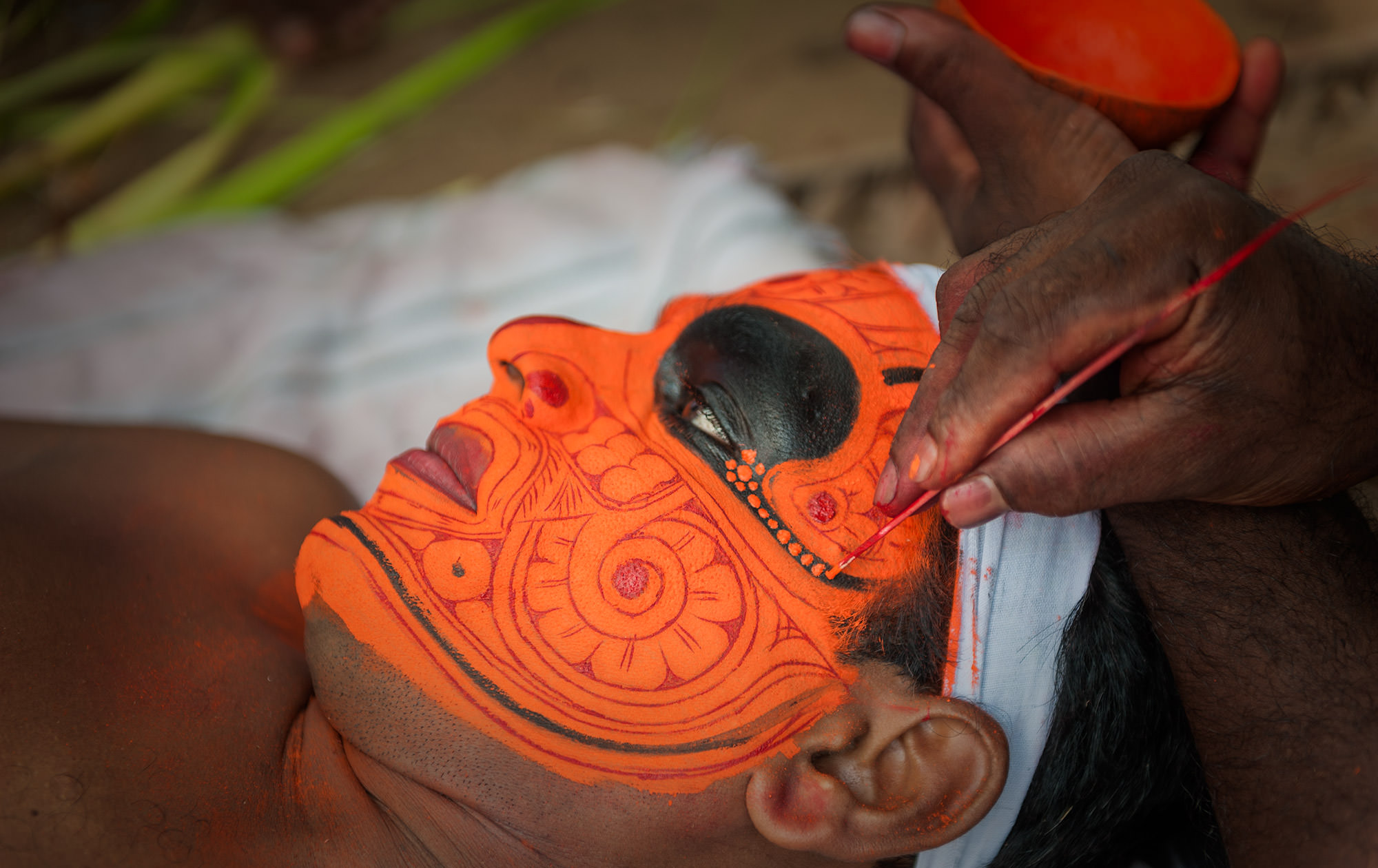
After finishing first round of the ceremony, people were resting and I was back to the Kavu. Behind the Kavu, on the edge of the clearing was a half-covered palm-leaf hut, and this has been occupied by the Gods (A troupe of Theyyam Artists) as their makeup room. Artists were getting ready in an open-air greenroom and I had a privileged entry to watch them. It was an amazing moment to watch the graceful makeup being dabbed on faces of otherwise average people to transform them into Gods.
I saw a well-built, muscular young man getting decked up by an old man. The makeup was made out of herbs and a slim strip of coconut leaf to hold it. It was a skilful drawing of loops, whirls and scorpion tail with some black fish shape around the eyes, trumpet spirals, then finishing the effects with a thin red stripe, adding some orange colour throughout his cheekbones. I sat down next to them to understand the makeup and was keen to know about the character he was to play. He was getting ready for Goddess Chamundi and when I saw him later he was completely metamorphosed. His entire body was painted in shiny red colour with a red glittering headdress. After the makeup was done, it was time to put on the ornaments, which were made of silver and gold. The next dancer to go was a fanged female figure representing the Goddess Bhagawati, with a red-painted face, supporting a huge red gilt, mirrored headdress. He was getting ready to summon the deity and I was told Goddess Bhagawati dresses up in a red coloured costume and red painted face. The whole makeup was a long process and each artist took almost 3 hours to get ready.
I was observing every move and saw the dancer gazing intently in a small mirror at the entrance of the open hut, identifying himself with the goddess. As I watched, the dancer stomped his feet, ringing the bells and cowrie shells on his anklets jerking his body suddenly tilting to one side to take a turn. As if he was struck by a high voltage current of electricity in his body was quivering, his hands shaking and his eyes were flickering from side to side. The figure who had been still and silently staring in the mirror a few seconds earlier had now transformed into Goddess Chamundi. He danced in a state of trance thrusting his head in a strangely eerie series of movements just that was part tropical fish, part stinging insect, part reptile and some part bird of paradise. Then just before I finally realised what was unfolding in front of my eyes, he was gone into the clearing, under the stars; he was followed by two attendants, both holding burning splints. And now, I was about to experience the extravaganza, which brought me here, to see the living God dancing in trance. Later in Kavu, he was offered a sword, the drummers were at their loudest best and it was a scene of intense action-packed high-energy dance. The dancer no longer seemed a mortal but felt like Goddess Chamundi had possessed him. He kept dancing and moving around to small temples in Kavu and gathering people around him. It was an extraordinary performance I had never seen before which continued for almost 3 hours. As the drum beats lowered so did the movements of the Goddess with blessings to follow starting with the kids to the elders of the village. A huge gathering of people surrounded around Kavu, flowers were plucked from the makeup and given to everyone as a sign of blessing from the Goddess herself. Offerings were made to the Goddess in the form of money and gifts. Even at that hour of the night, the people were pouring from everywhere and which seemed endless. I myself felt mesmerised by this gorgeous performance & silently wished it to continue forever. It was almost midnight when I started feeling little tried. Dinner was offered to me in the temple, but I did not want to miss any moment of this fabulous event while eating so I chose to starve myself. The villagers often tried speaking to me, though we didn’t speak the same language. But language is never a barrier when hearts talk. I was asked by almost 10 people if I had dinner. They said, “Now the event will be after 4-5 hours around 3:30 am, so please come home and take some rest until then”. People were very simple with a warm heart and friendly approach. I was very happy with the welcome & at the same moment I told my heart I have to be here again and yes I can say I was indeed in God’s own country.
It was resting time for people in the village but not for the Theyyam and the makeup artists. I turned back to same palm leaf hut, a temporary green room where I learned that there are three performances lined up. Fire-walk was one of them and the last performance of Goddess Bhagawati, which is the main Theyyam. I was amazed to hear fire-walk. I thought I heard it incorrectly and asked again, “Fire-walk?” Yes, I had heard it correctly; first performance in the morning will be fire-walk and finally Goddess Bhagawati by Theyyam.
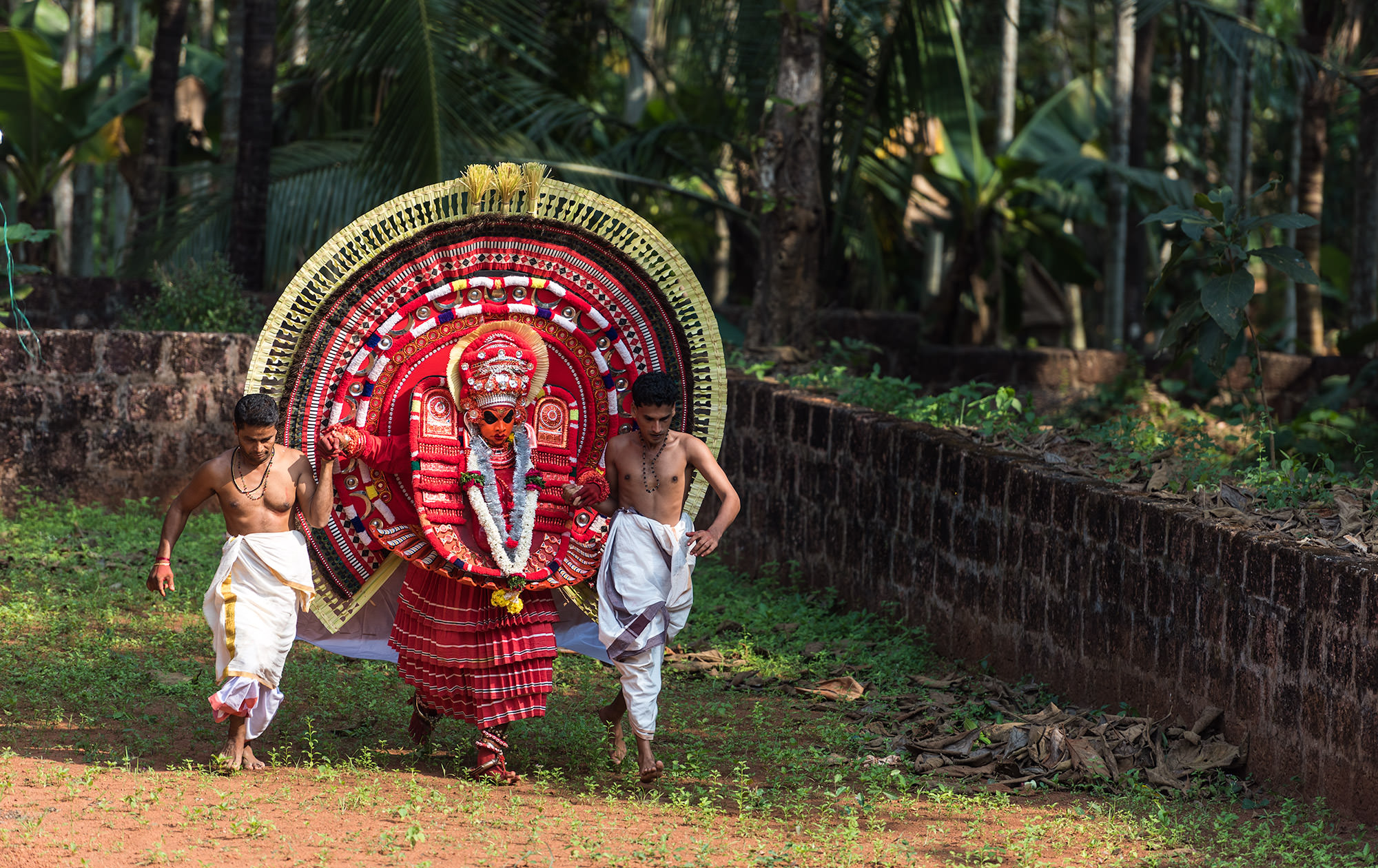
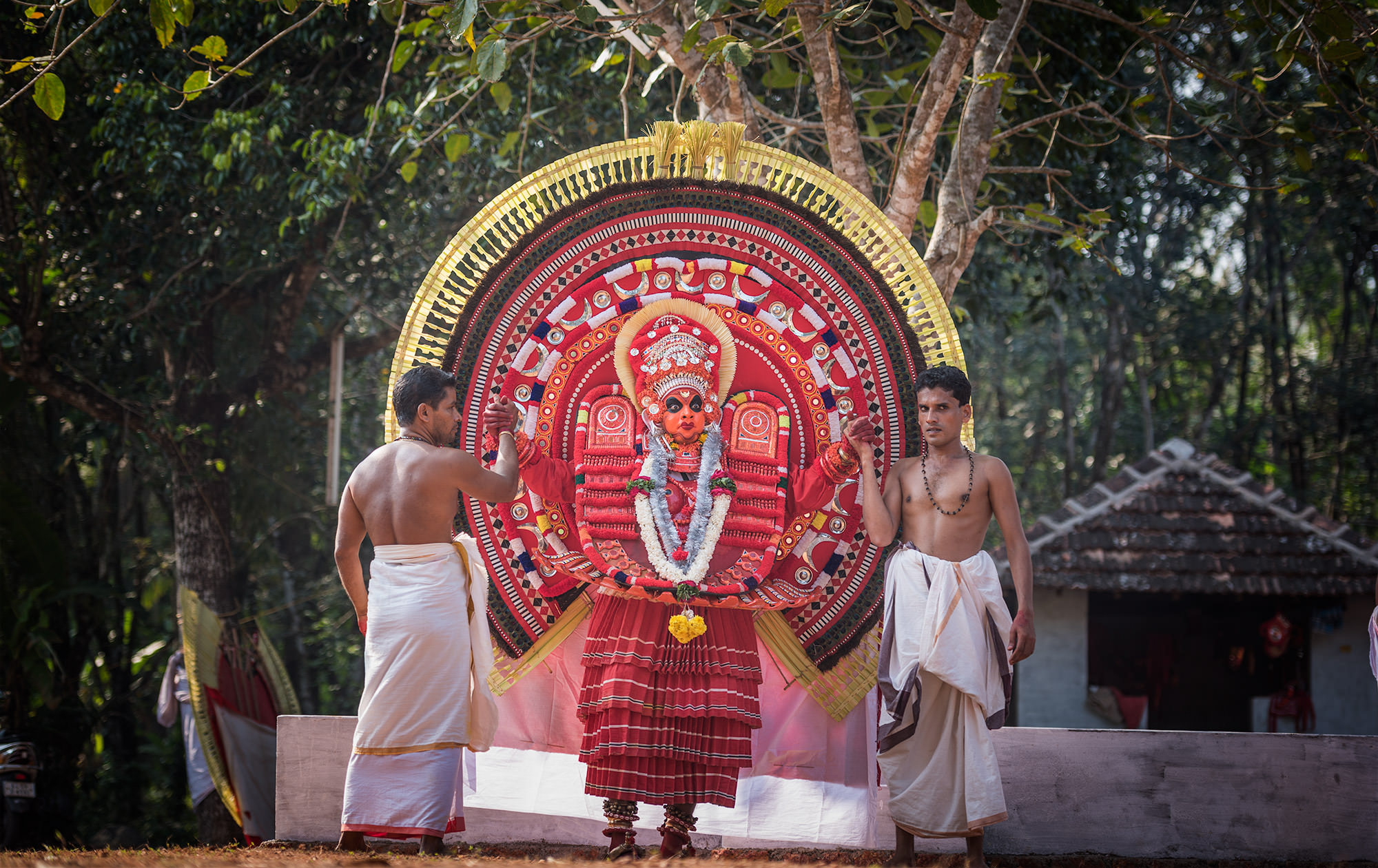
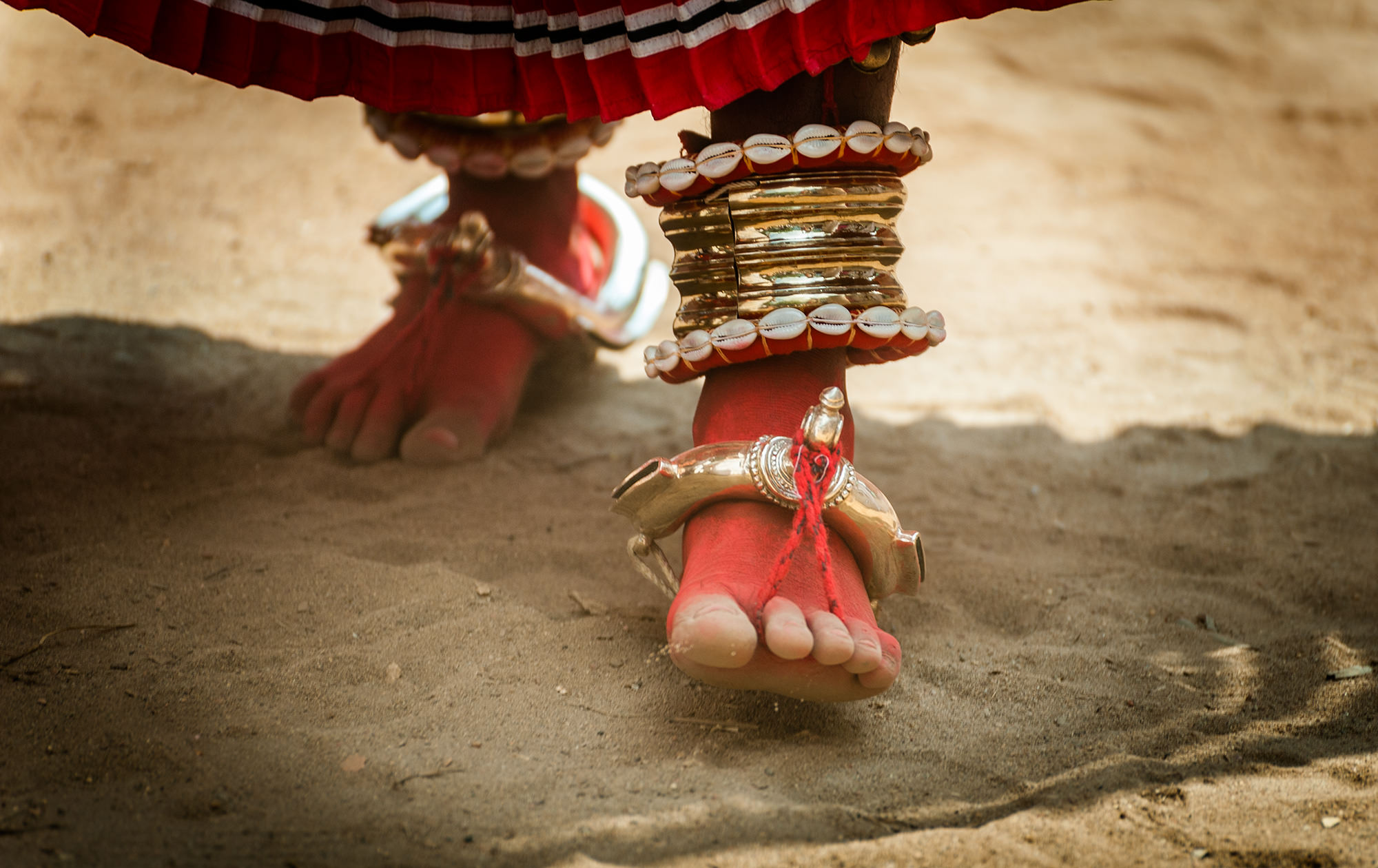
A group of volunteers were continuously adding wood to the fire to make sure it continues burning until the morning event of fire-walk. At around 2:30 am, suddenly firecrackers lit up the sky for almost 30 minutes. High drumbeats marked the start of yet another performance. This time the artist was getting ready for different kind of dress which was made out of grass, coconut and palm leaves. After a round of blessing from a deity, this young man was all ready to play with fire. The continuous beating of drums, the aroma of incense and the brilliant fire filled the entire atmosphere with the high energy of the divine presence. It took a while for me to understand what’s going on and why suddenly thousands of people gathered around fire. It was time to start the famous ritual of walking and playing with fire. The heat was high enough not to allow anyone to come close. I was standing near to it all sweaty and ready to witness and capture the epic fire-walk. Volunteers were sprinkling water around to cool the soaring temperature but it was of no use. Before water droplets could even touch you, they would evaporate in the air due to the sweltering heat. Suddenly a sound of cheers was heard and fire-walk started. A group of people started running and jumping over fire, it was an exhibition of faith in customs. It was a small temple ground with thousands of people with virtually no space to move. The real event starts with a play with fire with artist throwing himself in the fire and volunteers taking him out, The non-stop cheering of the crowd continued till 7.30 am with endless rounds of blessings and offerings.
The backyard of Kavu was a place always bustling with some action with artists either dressing up or with preparations related to the performance. I noticed a big crown was being made since late evening, well designed and made out of coconut & palm leaf and decorated with red silk cloth and flowers everywhere.
I was exhausted & had not sat for almost 18 hours, continuously running around. Actually, my curiosity did not allow me to sit for a minute. I saw some movement around greenroom and it was a man painted in red & dressed in a red costume with silver teeth protruding out near his cheeks. A silver applique chakra was stuck in the middle of his forehead, and around his waist was a thin strip of wild grass. The chest was covered with silver plates. It wasn’t difficult to recognise, that artist was goddess Bhagawati, the main Theyyam, was about to start. Drums were beating as high as it can be and the entire village was full of energy to welcome, finally God is on earth. The rhythm of the drums put the artist into a trance, fire was lit-up around dress and a big burning crown was put on his head. The artist was unrecognisable from before. His eyes were wide open, around dress and a big burning crown was put on his head. The artist was unrecognisable from before. His eyes were wide, charged and intense and his whole personality seemed to have been transformed.
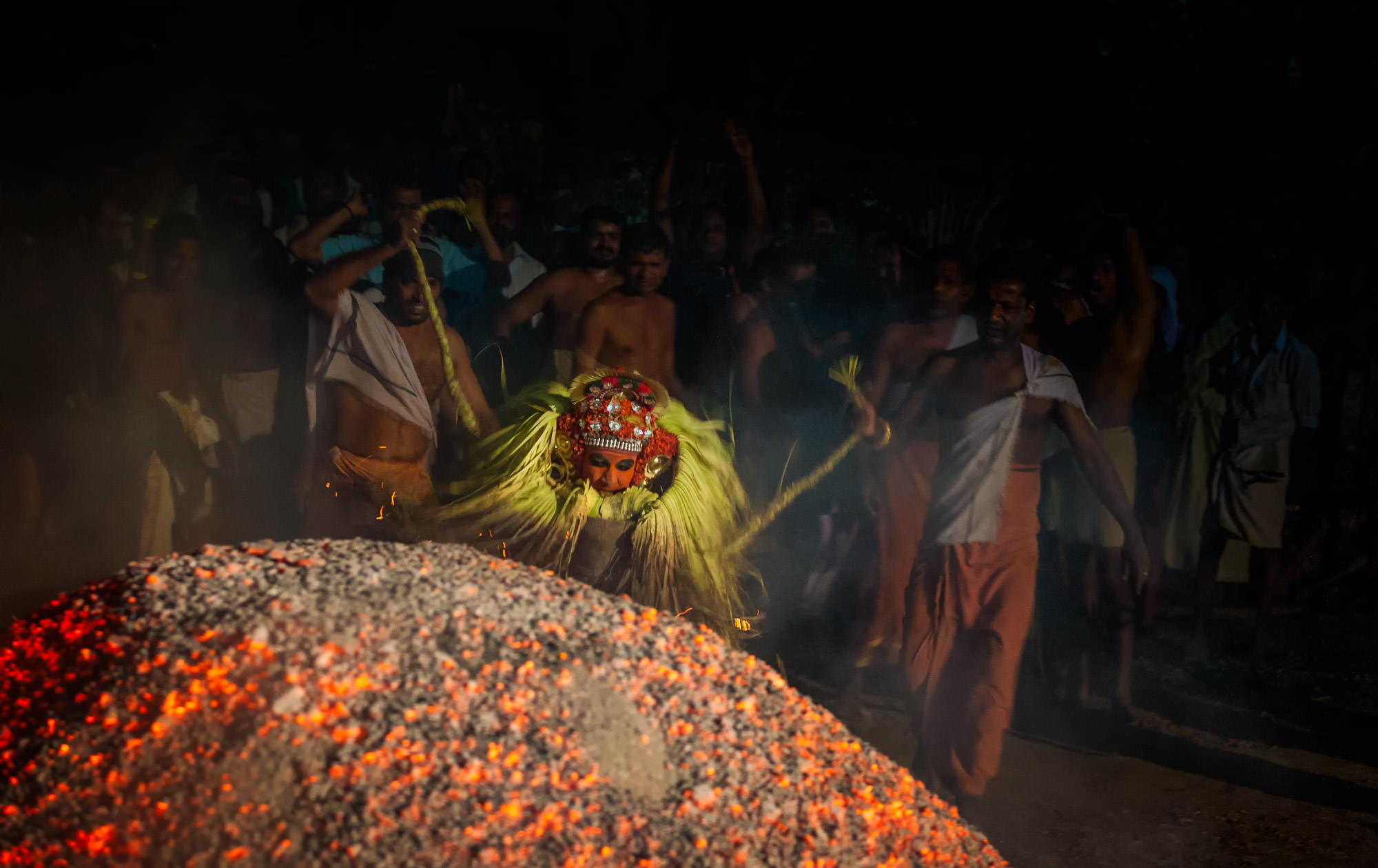
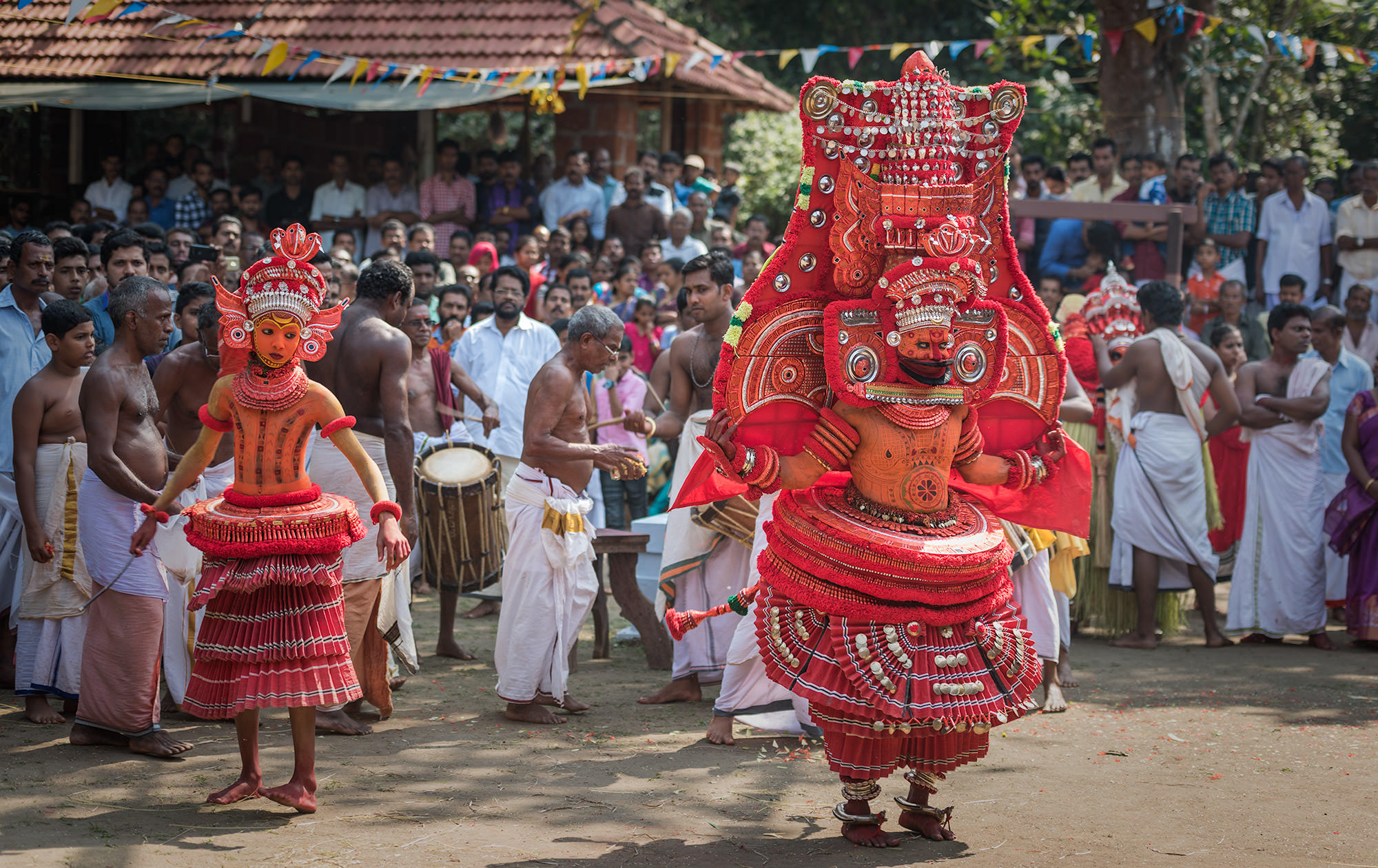
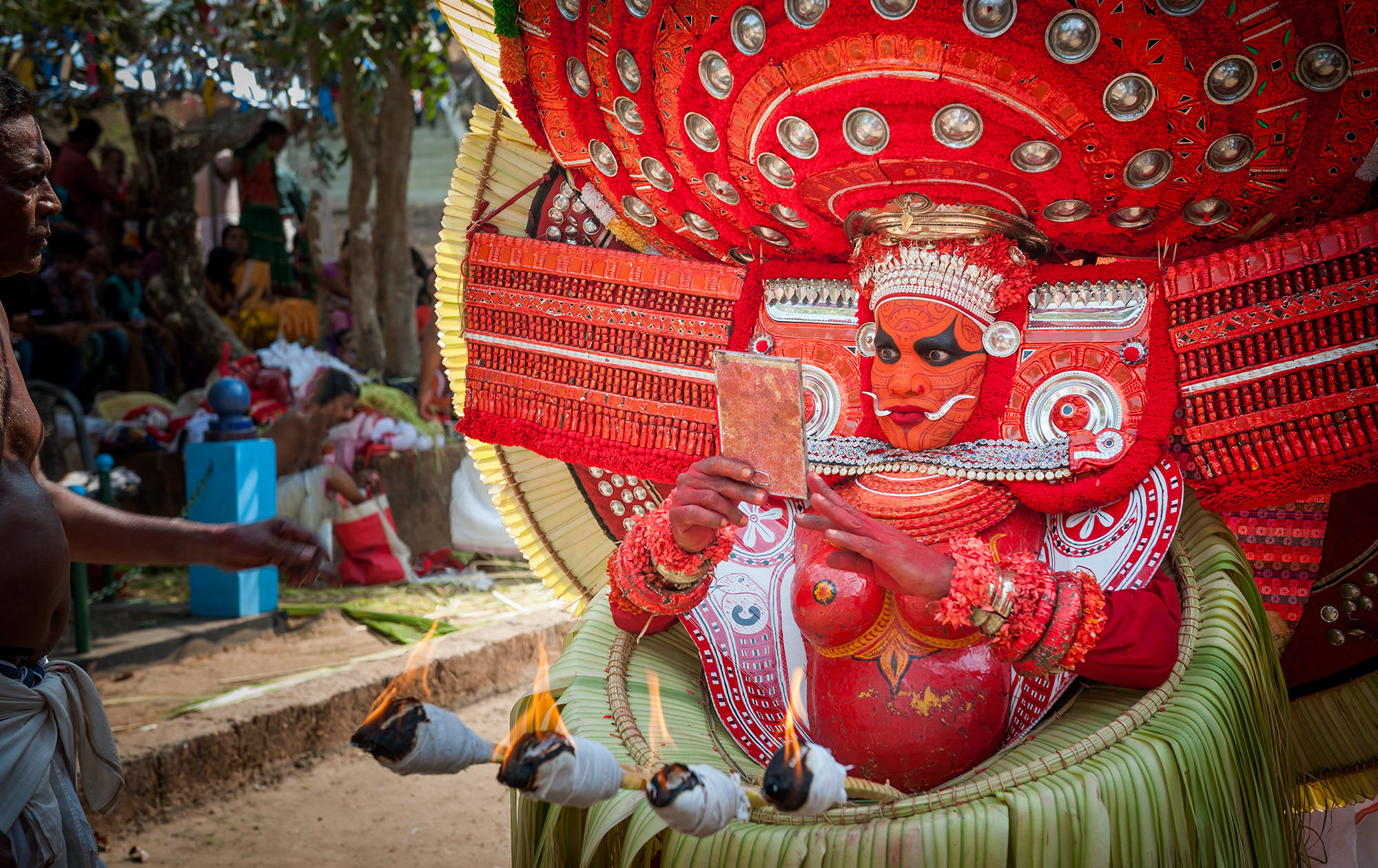
The calm, slightly earnest and thoughtful man I knew from my earlier meetings had now changed into a frenzied divine athlete. He made a series of spectacular leaps in the air as he circled the Kavu, twirling and dancing, spraying the crowd with showers of rice offering. I must say each dress must have weighed 40-50 kilograms for sure and wondered how a person can hold such a huge load on his head for a long time. But I forgot that it wasn’t a human but a God walking& dancing on earth and that’s definitely not difficult for him. Despite dancing all night there was no sign of exhaustion on the face of the artist. The energy was still high and the dancing continued. Rice was offered as a blessing to everyone by Goddess Bhagawati along with the forecast the New Year amidst songs. People falling at the feet of the Goddess to be blessed never seemed to cease. I found myself completely engrossed in the event. I hadn’t slept or sat for a moment for over the last 24 hours but it was well worth it. Finally, I did realise that my search for God ended here in God’s own country. It was then, that I realised why this place is known as God’s own country. Theyyam artists are still in mind and it was wonderful to talk to them throughout the event. The wonderful conversations with them gave me insights of living Gods.
Before I stop, here what Theyyam is all about:
The word “Theyyam” derives from ‘Daivam’, The Sanskrit word for ‘God’. Some scholars believe that the Theyyam of north Malabar is a rare survival of some pre-Aryan or non-Brahminical Dravidian religious system that was later absorbed into Hinduism’s capacious embrace. Others argue that the Theyyam was tolerated as an acceptable safety valve to allow complaints against the misdeeds of the upper castes to be expressed in a ritualised and nonviolent way.
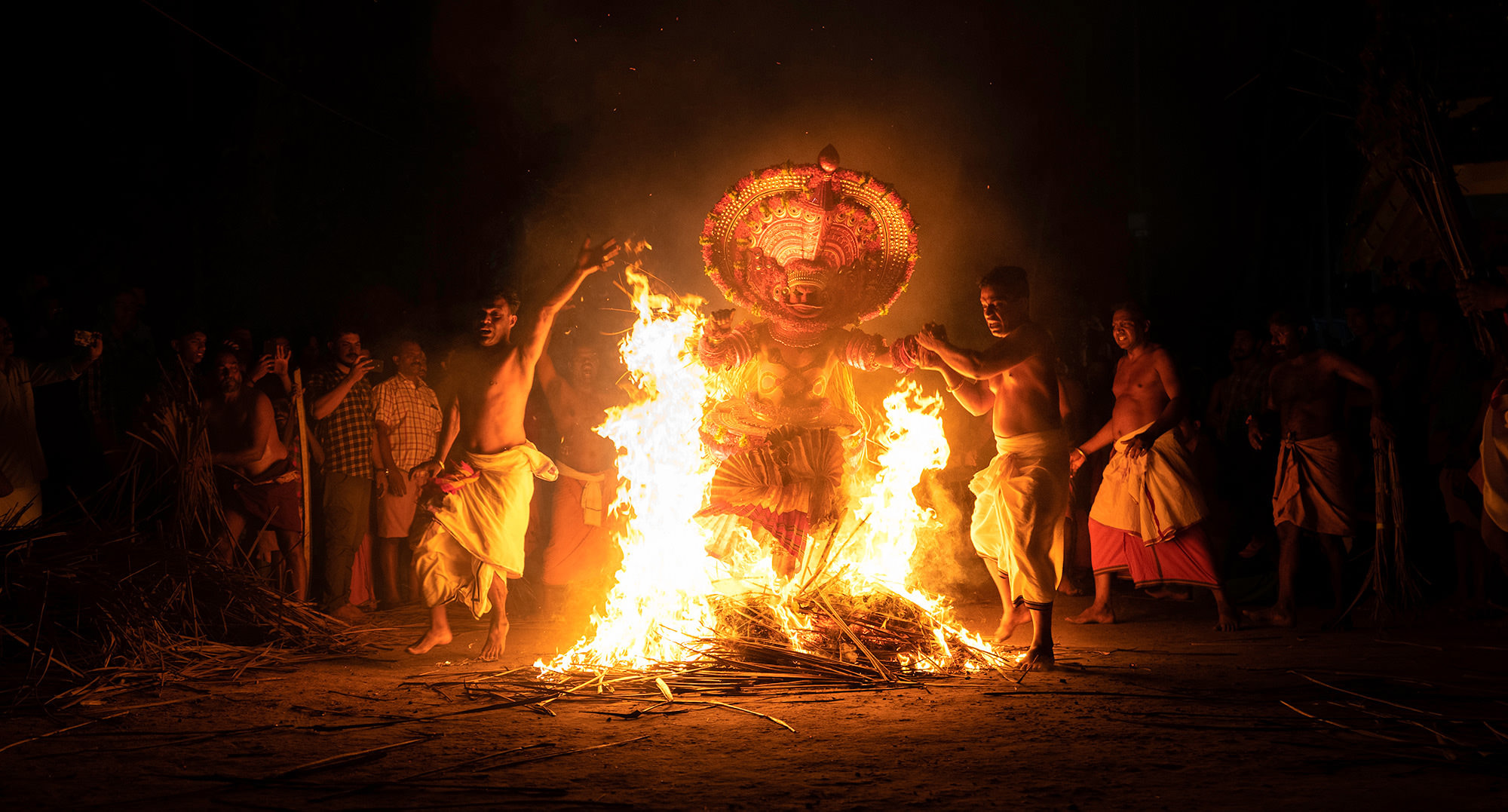
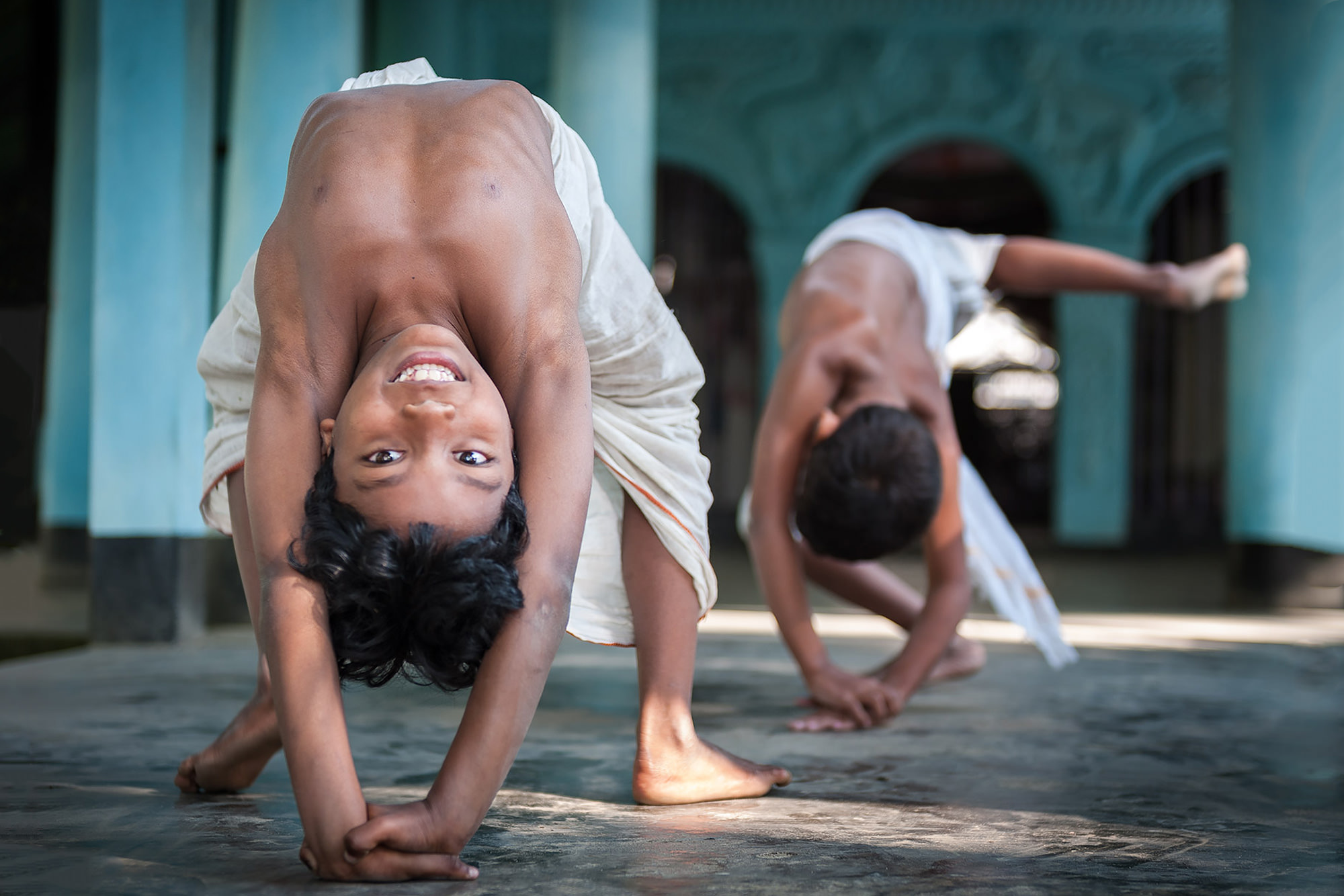
[…] last several hours and the artists wear even more elaborate paintings than in Kathakali. Check Manish's article and his fantastic photos taken during […]